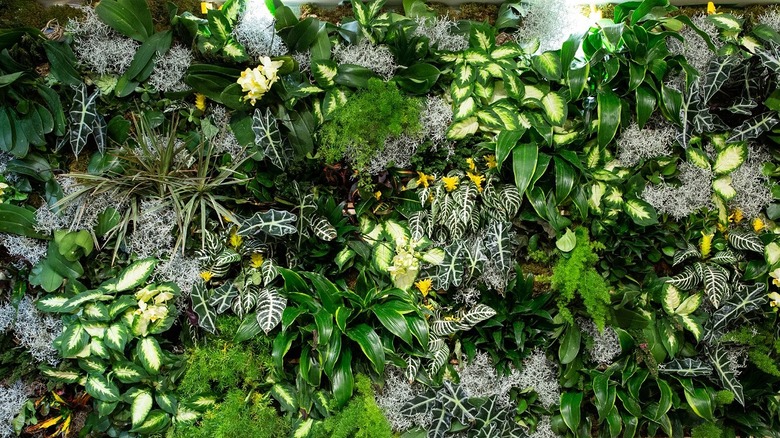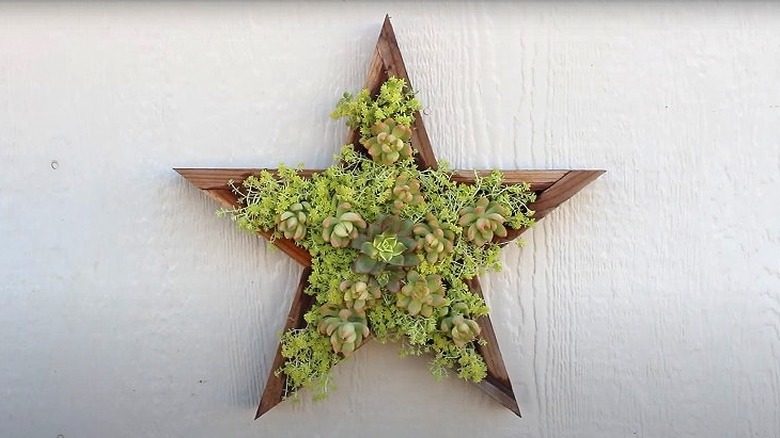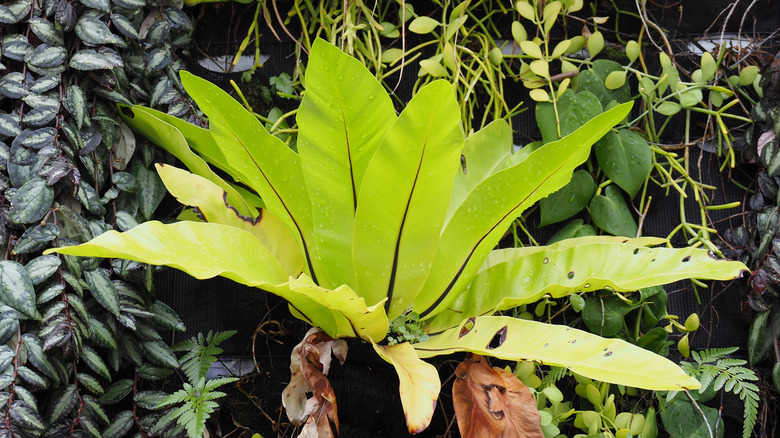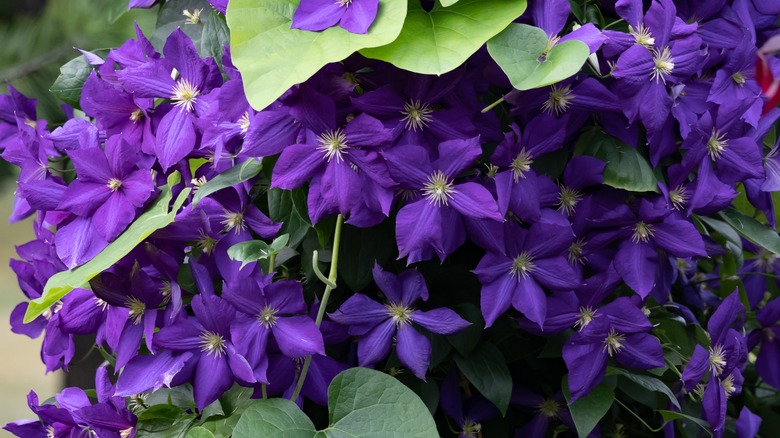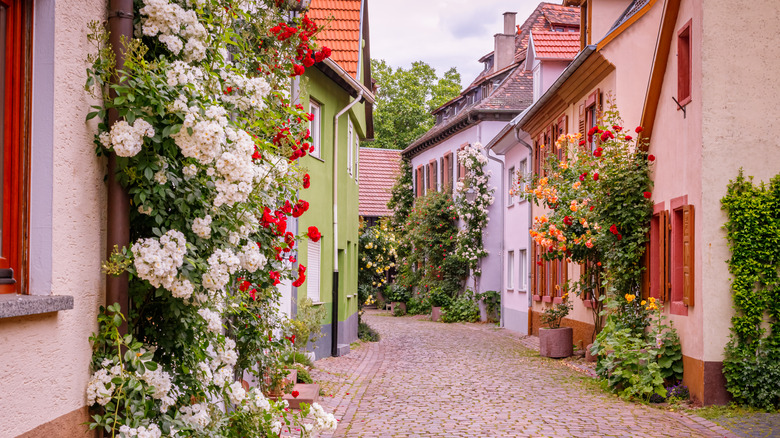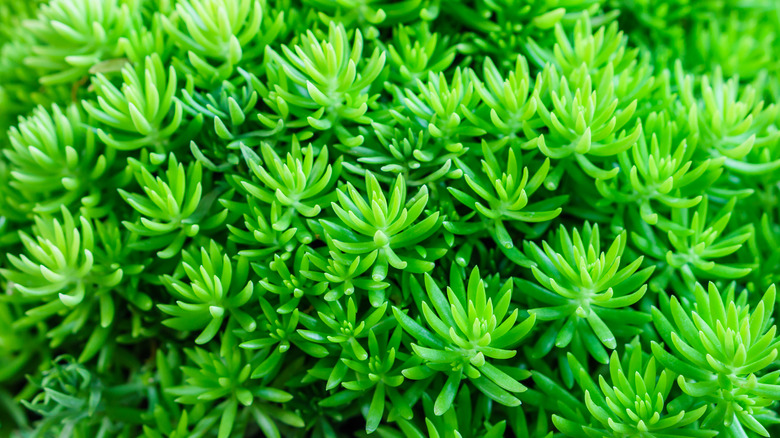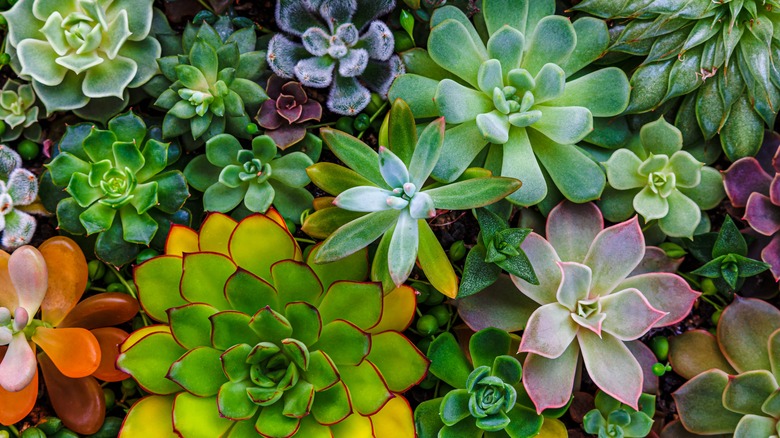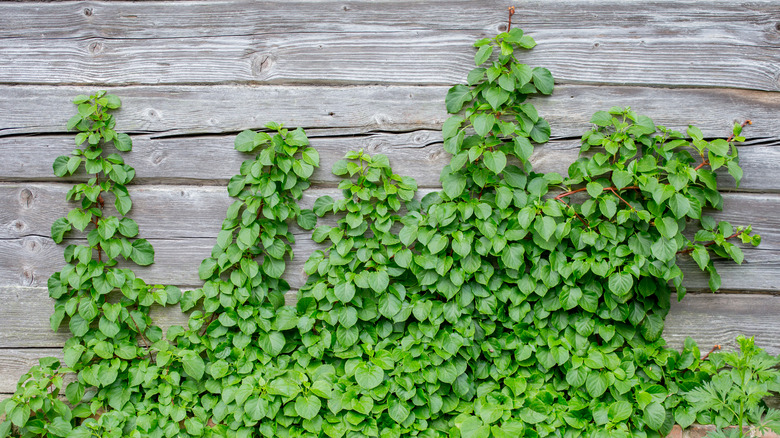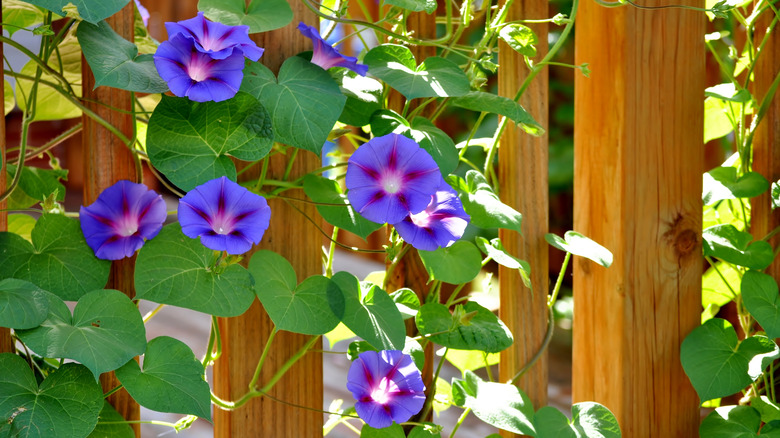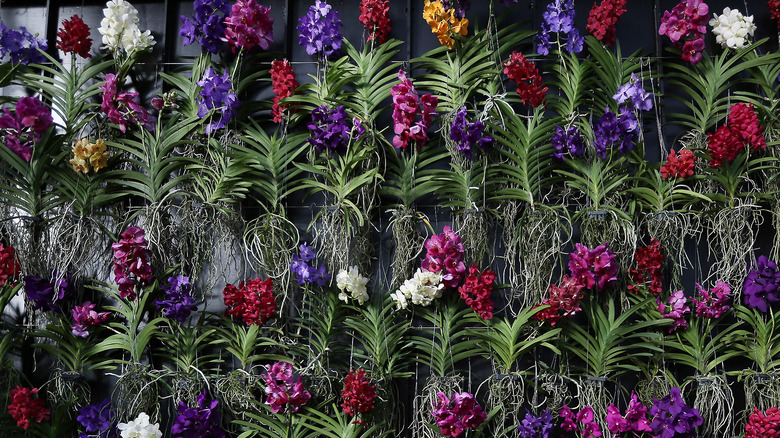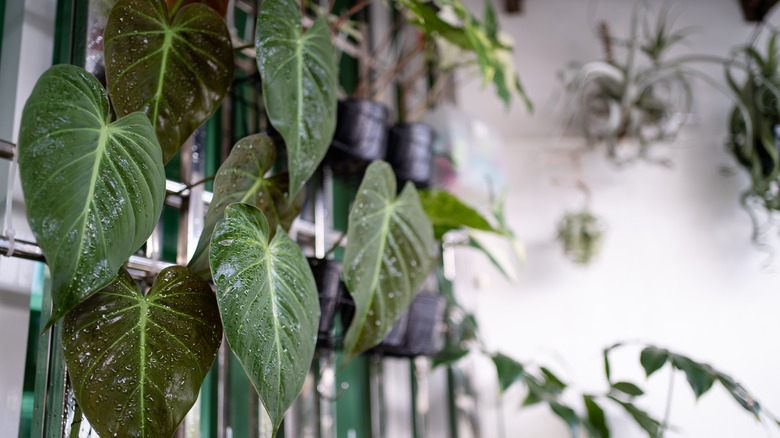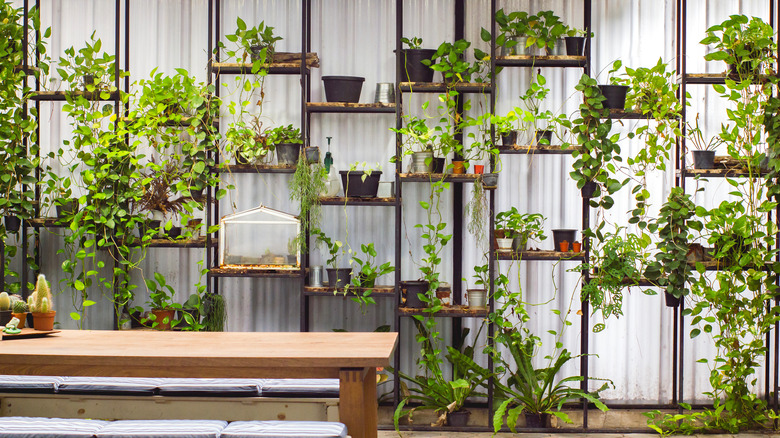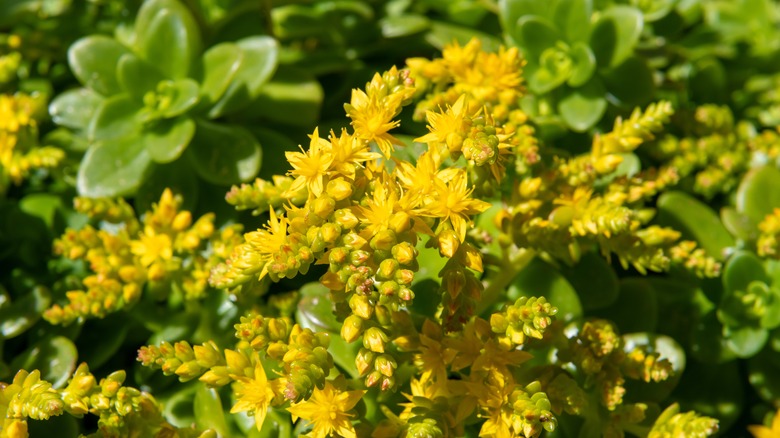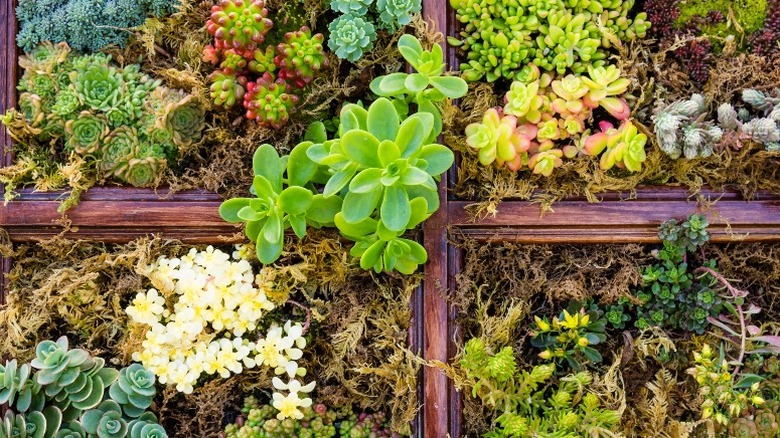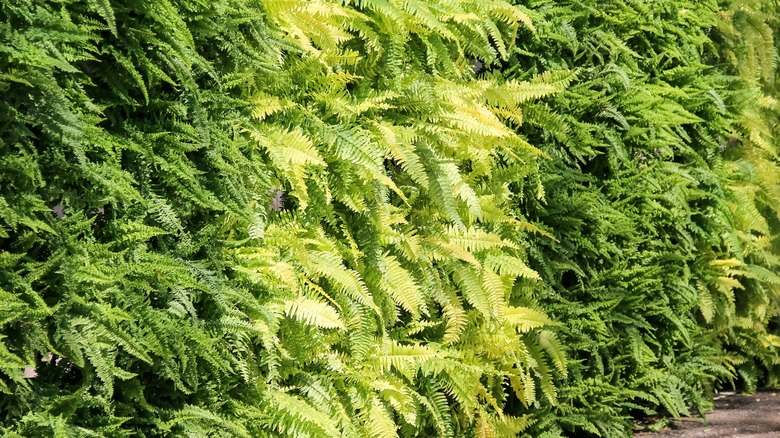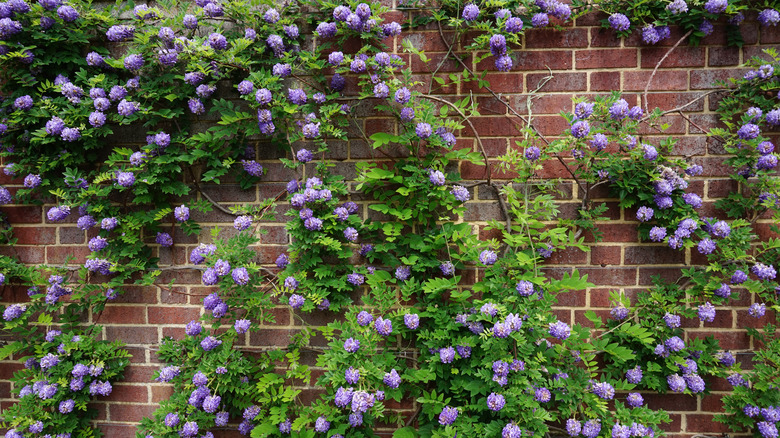15 Plants That Will Work In A Vertical Garden
When you think of a vertical garden your brain might leap to tomatoes and other vegetables you can grow outside with a trellis, yet there are many decorative plants that can be used to create a showstopping vertical display inside your home. Custom Home Group notes that vertical gardens come with both pros and cons. Perhaps best, they offer a way to fill up an empty wall and bring with them all the benefits of houseplants without taking up any floor or shelf space. While watering may prove difficult if you go all out with a large design or an entire living wall,there's no reason you can't start with a simple box frame hung on a sunny spot in your entryway.
Shallow-rooted plants, such as epiphytes, and those that retain water like succulents are perfect for an indoor setup. You'll find a bunch of those listed below, as well as some bright bloomers sure to up the wow factor with exciting washes of color. Alternatively, your vertical garden can be sown outdoors and trained to grow up and along a wall; you might find that larger vining flowers like hydrangeas and clematis are best for this arrangement, and especially those that prefer a solid day in the sun.
1. Aeonium
Aeoniums (Aeonium spp.) are drought-tolerant succulents with shallow root systems. Seen above, Mountain Crest Gardens uses a star-shaped wooden frame for a vertical planter (via YouTube), filling it with soil that's covered in moss before digging holes with a dowel to get the succulents situated in a dense pack.
Bloom Season: Rarely flowers indoors
USDA Growing Zone: 10 to 11
Growing Conditions: Full sun
Soil Type: Well-draining succulent mix
Size: 2 to 3 feet tall and 1 to 2 feet wide
2. Bird's nest fern
Bird's nest ferns (Asplenium nidus) are tropical epiphytes that are happiest when temperatures hover anywhere between 60 and 70 degrees Fahrenheit, according to NC State Extension. In a vertical garden, they will add pops of lime green color and some height differential as well. Remember that ferns generally like their soil to stay moist.
Bloom Season: Does not flower
USDA Growing Zone: 11 to 12
Growing Conditions: Dapple sun or partial shade
Soil Type: Loam, silt, high organic matter
Size: 3 to 5 feet tall and 2 to 3 feet wide
3. Clematis
You can trust a flower to grow well vertically when the Royal Horticultural Society refers to it as the "Queen of Climbers." Clematis (Clematis spp.) comes in a variety of colors, including purples, blues, pinks, and yellows. There are three types or groups of clematis: woody-stemmed with early blossoms; double and semi-double flowers, which may bloom twice (repeat bloomers); and large-flowered vines that bloom late in the season.
Bloom Season: Spring and summer
USDA Growing Zone: 4 to 8
Growing Conditions: Full sun
Soil Type: Loose and well-draining
Size: Depends on variety
4. Climbing rose
There is nothing quite like a wall of absolutely stunning climbing roses (Rosa spp.) that can reach over 20 feet tall. It's a visual extravaganza for the eyes as well as an olfactory delight for the nose. You could mix in some ivy or other vining greenery, but you may find a mix of various rose cultivars is all you need for a spectacular vertical display.
Bloom Season: Summer
USDA Growing Zone: Varies depending on cultivar
Growing Conditions: Full sun
Soil Type: Moist, well-draining
Size: Varies depending on cultivar
5. Crassula nudicaulis
Crassula nudicaulis is a warm-weather, bushy green succulent. It makes a nice fit for a box-frame vertical garden that you'd hang on the wall because it stays compact, growing only about 5 inches tall. This plant sends up offshoots, or pups, to continue its spread of growth; it's also easy to propagate by leaf cutting.
Bloom Season: Spring and summer
USDA Growing Zone: 9 to 11
Growing Conditions: Full to partial sun
Soil Type: Gritty, well-draining; tolerant of nutrient deficient soil
Size: Up to 5 inches tall
6. Echeveria
Echeveria elegans, sometimes called the Mexican snowball, may be the most recognizable echeveria variety, but there are many colorful options to choose from within this genus of succulents. Just like the Crassula nudicaulis, echeveria produce pups and can be propagated easily for those looking to expand their gardening skills.
Bloom Season: Late winter and early spring
USDA Growing Zone: 9 to 11
Growing Conditions: Full sun to partial shade
Soil Type: Well-draining succulent specific mix
Size: Up to 8 inches tall and 12 inches wide
7. Hydrangea vine
Hydrangea bushes make some of the best front-yard shrubbery, but there's a much less common vining cultivar (Hydrangea anomala petiorlaris) that will climb its way right up a wall before exploding into a flush of large white clustered blossoms. Just remember to keep your vines pruned because they can grow as long as 80 feet when left to their own devices!
Bloom Season: Summer
USDA Growing Zone: 5 to 9
Growing Conditions: Full sun to full shade
Soil Type: Fertile and well-draining
Size: 50 to 80 feet long
8. Morning glory
Morning glories (Ipomoea purpurea) may not be your first thought for an indoor vertical garden, but these voracious climbers can be grown inside provided they receive six to eight hours of direct sunlight per day, making south-facing windows an ideal location. Choose from over 1,000 different varieties to find the perfect hue to enhance your interior design.
Bloom Season: Early summer into fall
USDA Growing Zone: 9 to 11
Growing Conditions: Full sun
Soil Type: Well-draining standard potting mix
Size: 6 to 10 feet tall
9. Orchid
We're thinking a wall of orchids might be just about the most beautiful addition to a home possible. Wouldn't you agree? Indoors or out, epiphytic orchids have shallow root systems and so many available varieties, you're guaranteed to find something you love that will thrive in your environment.
Bloom Season: Varies depending on cultivar
USDA Growing Zone: Varies depending on cultivar
Growing Conditions: Dappled or bright indirect light
Soil Type: Orchid specific potting mix
Size: Varies depending on cultivar
10. Philodendron
Philodendrons come in all sorts of shapes and sizes, and the heartleaf variety (Philodendron hederaceum) is certainly very popular for its vining growth habit. You may see the same plants labeled as sweethearts or philodendron micans. Either way you'll have a lovely heart-shaped climber to fill out your vertical display.
Bloom Season: Rarely flowers indoors
USDA Growing Zone: 11 to 12
Growing Conditions: Part shade
Soil Type: Standard potting mix
Size: 10 to 20 feet all and 3 to 6 feet wide
11. Pothos
Pothos, or devil's ivy, (Epipremnum aureum) is one of the most recognizable houseplants. Easy to take care of and sporting long trails of lush variegated greenery, a pothos can be trained along a trellis or placed high and left to cascade downwards. This plant also has the unusual nickname of centipede tongavine.
Bloom Season: Rarely flowers indoors
USDA Growing Zone: 10 to 11
Growing Conditions: Partial sun, dappled shade, or full shade
Soil Type: Standard potting mix
Size: 6 to 12 inches tall
12. Sedum
Sedum is a genus offering some 600 options of greenery, and many of them would thrive in a vertical planter. For a splash of undeniable cheer, consider the Sedum confusum variety (shown above), which shows off bright yellow star flowers in the summer and thick succulent leaves throughout the year.
Bloom Season: Summer
USDA Growing Zone: 7 to 10
Growing Conditions: Full sun to part shade
Soil Type: Succulent specific potting mix
Size: 7 to 10 inches tall and 15 to 18 inches wide
13. Sempervivium
Similar to sedum, yet offering height contrast and differing colors, sempervivium (Sempervivium spp.) require very little water or attention and will fasten nicely into a vertical frame garden. Also known as the common houseleek, or the hens and chicks plant, these succulents are appreciated for their tolerance and overall hardiness.
Bloom Season: Spring and summer once plant reaches between 2 and 5 years old
USDA Growing Zone: 4 to 8
Growing Conditions: Morning sun followed by afternoon shade
Soil Type: Succulent specific potting mix
Size: .25 to 10 inches in diameter
14. Sword fern
Sword or Boston ferns (Nephrolepis exaltata) could be grown up and over a partially shaded wall in the backyard, but they also do remarkably well indoors, especially in rooms with high humidity, as the Missouri Botanical Garden notes. Paired with other moisture-loving houseplants, sword ferns would work great in a framed vertical garden situated in a bathroom.
Bloom Season: Does not flower
USDA Growing Zone: 10 to 12
Growing Conditions: Part shade
Soil Type: Moist, humus-y, well-draining
Size: 2 to 3 feet tall and wide
15. Wisteria
Gorgeous purple wisteria flowers (Wisteria frutescens) — best suited for the outdoors — will quickly take over any wall in sight for a stunning vertical display. While this vine will survive in a partially shaded area, you'll want to give yours as much direct sun exposure as possible to get the largest abundance of flowers.
Bloom Season: Spring and summer
USDA Growing Zone: 3 to 9
Growing Conditions: Full sun to partial shade
Soil Type: Fertile, moist, well-draining
Size: 10 to 30 feet tall
